To make creating your plan easier, I've put together a list of what to include. I’ve also compiled a few different strategic marketing plan templates where you can easily fill in the blanks.
In this article, we're going to discuss:
- What should a marketing plan include?
- Marketing Plan Timeline
- How to Create a Marketing Plan
- HubSpot’s Free Marketing Plan Template
- One-Page Marketing Plan Template
- Strategy-specific Marketing Plan Templates
What should a marketing plan include? [Marketing Plan Outline]
A marketing plan is a roadmap that businesses like yours use to organize, execute, and track their marketing strategy over a given period.
The marketing plan outline we discuss will help you create an effective plan that easily generates buy-in from stakeholders.
Download This Marketing Plan Outline for Free
Marketing plans can get quite granular depending on your industry and how big your digital presence is. This is true whether you're selling to consumers (B2C) or other businesses (B2B).
Despite these nuances, here are the essentials I’ve found should be present in every marketing plan or marketing planner template:
Business Summary
In a marketing plan, a business summary is exactly what it sounds like — a summary of the organization.
It gives all stakeholders a refresher on your company before delving into the more strategic components of your plan. It also gives them something easily accessible to refer to if they have questions during their review.
At a minimum, most business summaries include:
- Company name
- Location
- Mission statement
Our marketing plan outline also includes information on marketing leadership, which is especially helpful for companies with large marketing teams.
SWOT Analysis
Your marketing plan's business summary should also include a SWOT analysis. This summarizes your business's strengths, weaknesses, opportunities, and threats (SWOT).
Creating a SWOT analysis is an important strategic exercise (and call me a marketing nerd, but I find it fun). It gives everyone involved a clear picture of the environment your business is working in and how it is doing within it.
It’s like a quick therapy or wellness check-up for business. You see where you’re at and perhaps even get to vent a bit before taking steps to improve things.
Including a SWOT in your marketing plan reminds readers of what circumstances are being considered in your strategy.
Pro Tip: In my experience, it’s good to have stakeholders from every section of the business contribute to creating your SWOT analysis so that nothing is overlooked.
To become truly accurate, it requires thorough market research, data analysis, and competitive analysis.
Revisit your SWOT every time you work on your marketing plan, as your audience and competition will inevitably evolve.
Business Initiatives

What is your marketing team working on? What do you want to work on?
Document them in your marketing plan under business initiatives. This section sets the tone for the rest of the document and its strategies.
Be careful not to get bogged down by big-picture company initiatives (i.e., opening a new location in X city or recruiting new talent via the Y platform), which you'd normally find in a business plan.
This section should outline the projects specific to marketing. You‘ll also describe those projects’ goals, which will be measured.
Every initiative should follow the SMART framework for goals — meaning they are specific, measurable, attainable, relevant, and time-bound.
For example, a broad goal might be, “Increase my Facebook following.” But a SMART version could be, “Increase my Facebook following by 30% by June.” See the difference?
Target Market
Next, consider your target market, or the audience you are trying to reach with your marketing messages. This includes your industries and buyer personas.
Industries
If you’re B2B, you’ll want to include a description of the industries your customers typically work in or those where your products or services are used. If you’re B2C, you can disregard this section.
Buyer Personas
A buyer persona is a semi-fictional description of your ideal customer. It focuses on traits like:
- Age
- Location
- Title
- Goals
- Personal challenges
- Pains
- Triggering event
It’s a more specific characterization of your target market or the types of people you want to work with.
This section of your marketing plan should just be a brief summary of your greater buyer persona document to remind readers who your initiatives are speaking to.
Competitive Analysis
Your buyer persona has choices regarding solving their problems, the types of solutions they consider, and the providers that can administer those solutions.
A competitive analysis will detail the companies or brands you’re up against, which should be considered in your marketing strategies.
Consider who your competition is, what they do well, and where the gaps are that you can fill. This can include:
- Positioning
- Market Share
- Offerings
- Pricing
Our marketing plan template includes space to list the specific products you compete with. You can also include other facets of the other company’s strategy, such as their blogging efforts or customer service reputation.
Keep this part of your plan simple. Your full competitive analysis should be done separately.
Here are a few competitive analysis templates to get started.
Market Strategy
I know what you’re thinking, isn’t this whole plan our marketing strategy? And you’re right to a degree, but this section focuses more on outlining what a brand needs established to go to market.
In our full-length marketing plan outline, the market strategy section contains the “seven Ps of marketing” (or the “extended marketing mix”):
- Product
- Price
- Place
- Promotion
- People
- Process
- Physical Evidence
(Note: You'll learn more about these seven sub-components inside our free marketing plan template, which you can download here.)
But it doesn’t simply list these details.
The market strategy in your marketing plan is where all the pieces come together. Your market strategy describes how your company should present itself in the market, keeping in mind its SWOT, competitors, consumers, and goals.
For example, if you found that one of your competitors employs stronger social media marketing strategies, you might add “We'll post 3 times per week on our social media profiles” under “Promotion.”
Budget
When I created my first marketing plan, I confused the marketing budget section with my product's price and other financials. That’s what “price” in your market strategy is for.
This section describes how much money the business has allotted for the marketing team to pursue the initiatives and goals outlined in the elements above.
Depending on how many individual expenses you have, you may want to itemize your budget for clarity. Example marketing expenses include:
- Outsourcing costs to a marketing agency and/or other providers
- Marketing software
- Paid promotions
- Events (those you'll host and/or attend)
Remember, your marketing plan only includes a summary of the costs. Keep a separate document or Excel sheet to help you calculate your budget much more effectively. Here’s a marketing budget template to get started.
Marketing Channels

Your marketing plan should also include a list of your marketing channels.
While your company might sell the product using certain ad space, your marketing channels are where you'll publish the content. This content educates your buyers, generates leads, and spreads brand awareness.
If you publish (or intend to publish) on social media, this is the place to discuss it. (We’ll explore social media marketing plan templates that will help you get more granular a little later.)
Our template focuses on digital platforms (websites and social media), but you can include other mediums, such as newspapers and radio ads, if necessary.
With social media as an example, use the marketing channels section of your marketing plan to map out which social networks you want to launch a business page on. You should also highlight what you‘ll use this social network for and how you’ll measure your success.
If you also have a blog, it might be smart to leverage content marketing tools and repurpose long-form content into smaller social media posts. This helps drive extra traffic to your website and maximize ROI. But be sure to mention it in this section.
Part of this section's purpose is to prove to your superiors, both inside and outside the marketing department, that these channels will serve to grow the business.
Marketing Technology
Last but certainly not least, your marketing plan should include an overview of the tools in your marketing technology (MarTech) stack.
These are the tools that help you achieve the goals you outlined in the previous sections. Since all types of marketing software usually need a generous investment from your company’s leadership, connecting them to a potential ROI for your business is essential.
For each tool, describe what you’ll use it for, and be sure it’s consistent with the strategies you’ve outlined elsewhere in your marketing plan.
For instance, we wouldn't recommend listing an advertising management tool if you didn’t list “PPC Advertising” under “Marketing Channels.” This may raise eyebrows.
Pro tip: If you’re going for a unified marketing solution that accomplishes many goals, still do your due diligence. Describe all of the ways you’ll use the software and why it’s the best option.
When discussing marketing analytics software, specify what metrics you’ll track with it, why those metrics are necessary, and how it will benefit your overall marketing strategy.
Marketing Plan Timeline
Rolling out a new marketing plan is a big lift. To ensure smooth project progress, create a timeline that maps out each project's schedule.
A marketing plan timeline allows your team to view all projects, campaigns, events, and other related tasks in one place — along with their deadlines.
This ensures everyone on your team knows what’s due when and what’s up next in the pipeline.
Typically, these plans cover marketing efforts for the entire year, but some companies may operate bi-annually or quarterly.
Once you’ve completed your analysis, research, and goal setting, it’s time to set deadlines for your assignments. From new content initiatives to product launches, everything will need a deadline. Take into account any holidays or events taking place over the course of the year.
While setting deadlines for the entire year may seem daunting, start by estimating how long you think each task will take. Then, set a deadline accordingly. Track the time it actually takes for you to complete similar types of projects.
Once you’ve completed a few of them, you can set more accurate deadlines. Looking for more tactical support? This guide breaks down how to develop a content plan that aligns with business goals — from ideation to execution.
For each project, you’ll want to build in time for:
- Brainstorming: This is the first phase where your idea comes to life in a project outline. Decide what you want to achieve and which stakeholders must be involved to meet your goal. Set a due date and set up any necessary meetings.
- Planning: This can include determining the project’s scope, determining its budget, finalizing deadlines, and determining who is working on each task. It also includes mapping out any campaigns needed for each project (social media, PR, sales promotions, landing pages, events, etc.).
- Execution: This third phase is all about your project launch. Decide on a date to launch and monitor the progress of the project. Set up a system for tracking metrics and KPIs.
- Analysis: In this final phase, you will analyze all of your performance data to see whether or not your marketing efforts paid off. Did you meet your goals? Did you complete your projects on time and within budget?
Pro tip: All projects and their deadlines should be in a central location where your team can access them. This may be a calendar like HubSpot's tool, shared document, or project management tool.
With the outline mentioned above, here’s how you should go about creating your marketing plan.
1. Research, research, research.
The first step in creating a marketing plan is conducting market research. This is where I gather all the data and insights to complete SWOT and competitor analyses.
Additionally, I need a good picture of the current market. How do I compare to my competitors? What are they missing? What can I offer that'll give me a competitive advantage? Doing a competitor analysis can help.
Answering questions like this should help you figure out what your customer wants, which brings us to step number two.
2. Define and refine your target audience.
Who are you trying to market to? Who buys your product or service?
If your company already has buyer personas, this step means you should review and refine your
current personas. But if you don't, you should create one.
Your buyer persona should include demographic information such as age, gender, and income, as well as psychographic information such as pain points and goals.
What drives your audience? What problems do they have that your product or service can fix?
Once you have this information written out, it'll help you define your goals, which brings us to step three.
3. Define your SMART goals.
My mother always used to tell me, “You can't go somewhere unless you have a road map.”
For someone geographically challenged, like me, that was literal advice. But it can also be applied metaphorically to marketing.
You can't improve your ROI unless you know your goals.
After you've figured out your current situation and know your audience, you can begin to define your SMART goals.
SMART goals are specific, measurable, attainable, relevant, and time-bound. This means that all your goals should be specific and include a time frame for which you want to complete them.
For example, your goal could be to increase your Instagram followers by 15% in three months.
Before you start any tactic, write them out. Then, you can begin to analyze which tactics will help you achieve that goal. That brings us to step number four.
4. Analyze your tactics.
What tactics will help you achieve your goals? What are the right channels and action items to focus on?
This is where you figure that out.
If your goal is to increase your Instagram followers by 15% in three months, your tactics may include hosting a giveaway, responding to every comment, and posting three times a week.
Once you know your goals, brainstorming several tactics to achieve them should be easy.
That said, you may not be able to pursue every tactic on your list (unless you have an unlimited budget, which, if so, jealous). This brings us to step number five.
5. Set your budget.
Before you can begin implementing any of the ideas that you've come up with in the steps above, you have to know your budget.
For example, your tactics might include social media advertising. However, if you don't have the budget for that, then you might not be able to achieve your goals.
While you‘re writing out your tactics, be sure to note an estimated budget. You can include the time it’ll take to complete each tactic in addition to the assets you might need to purchase, such as ad space.
6. Document it.
With all our information in hand, now you need to document it. Next, we’ll talk through three different templates you can follow:
- HubSpot’s Free Marketing Plan Template
- A One-Page Marketing Plan Template
- An AI-generated Marketing Plan Template
HubSpot’s Free Marketing Plan Template
To help you get started with your marketing plan, HubSpot has a free marketing plan template ( (or marketing planner template):
Download your marketing plan template here.
Who’s it right for?: Anyone! But especially businesses whose marketing efforts are focused online.
What I like: The template is an easy-to-use, editable word document. It opens automatically in Microsoft Word (or your word processing software of choice), and you can click right into each field to make changes.
It also includes all of the essential elements we discussed earlier:
- Business Summary (with SWOT Analysis)
- Business Initiatives
- Target Market (with buyer personas and competitive analysis)
- Market Strategy
- Budget
- Marketing Channels
- Marketing Technology
While focused on digital methods, it can be easily edited to include more methods like traditional media as well.
Let’s take a look at what each section may look like completed using the template.
Business Summary
Include your company name, a list of the individuals responsible for enacting the different stages of your plan, and a brief mission statement.
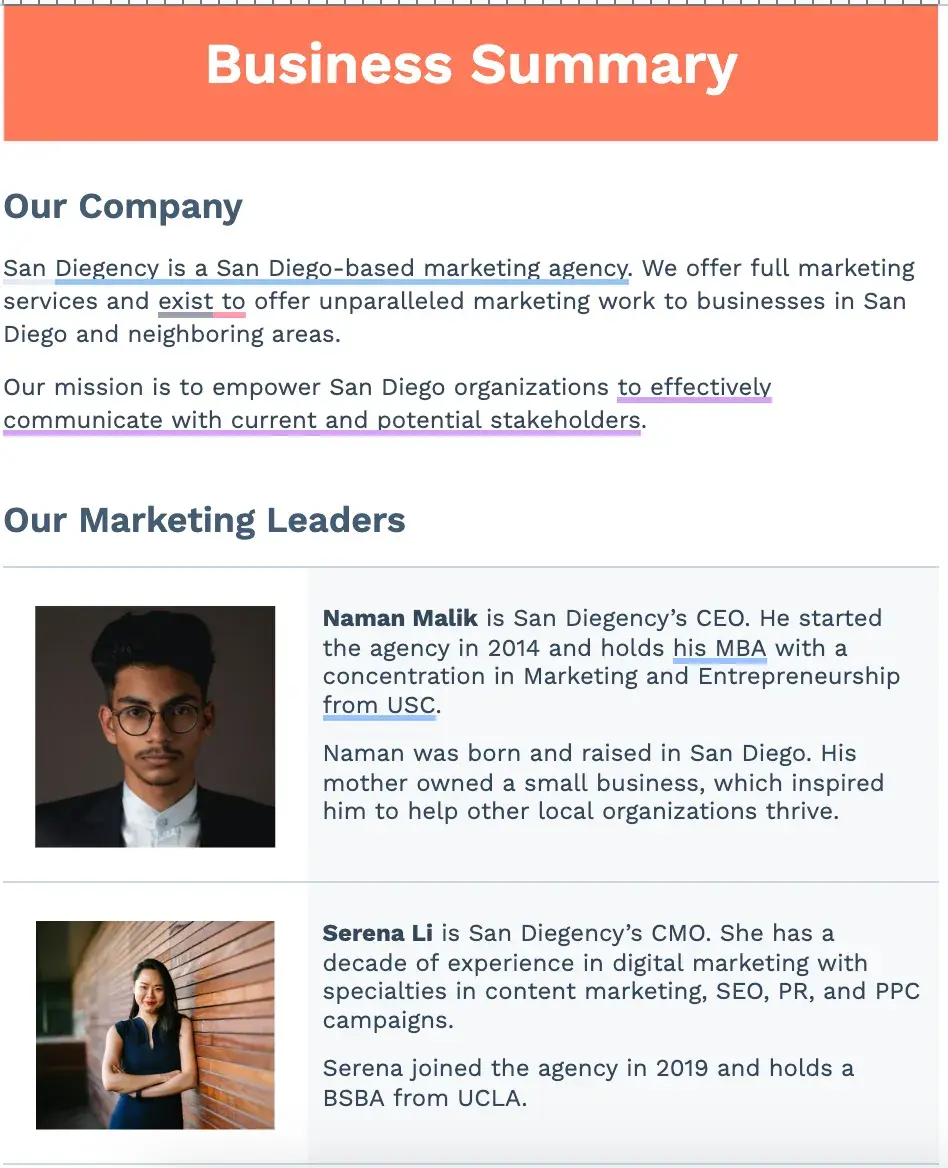
Business Initiatives
This is where you document what your business is focusing on from a marketing perspective. They are the projects that every other strategy feeds into.

Target Market
Outline your target audience(s) that your efforts will reach. You can include a brief overview of your industry and buyer personas.

Budget
This is an overview of the money you’ll spend to help you meet your marketing goals. Create a good estimate of how much you'll spend on each facet of your marketing program.

Marketing Channels
List the channels you’ll use to achieve your marketing goals. Describe why you're using each channel and what you want to accomplish so everyone is on the same page.

One-Page Marketing Plan Template
As you may have gathered, a marketing plan covers a lot of information, but it doesn’t have to be a long document. And frankly, sometimes you don’t want it to be.
When you have to share information with busy stakeholders or need information at a glance, a one-page marketing plan can be the right solution.
Marketing agency Llama Lead Gen has a free one-page PDF template that includes everything we discussed earlier.

Who’s it right for?: This is a great solution for small businesses that want to organize their thoughts, businesses just getting off the ground, or any organization just looking for a quick “cheat sheet” on their marketing plan.
What I like: It also includes a one-page template for summarizing your customer journey and buyer personas.
Strategy-specific Marketing Plan Templates
Marketing is a broad umbrella that covers specialties like email marketing, content marketing, and search engine marketing.
In the next sections, we will break down three of the most common strategy-specific marketing plans you may need:
We will also share templates to help you create them.
Marketing Campaign Plan Template
Your marketing plan is a high-level view of the different marketing strategies you’ll use to meet your business objectives. A marketing campaign template, on the other hand, is a focused plan to help achieve those goals.
For example, if your marketing initiative is to generate more qualified boost revenue at your clothing store, your marketing campaign may be a sale called the “Summer Sale Spectacular.”
A marketing campaign template should include the following key components:
- Campaign Overview
- Campaign Strategy
- Timeline and Milestones
- Budget & Resources
- Campaign Creative & Assets
- Promotion and Distribution
- Metrics & Analytics
- Team Roles & Responsibilities
Pro Tip: HubSpot has a free editable template with all of these elements for you. Let’s go a little deeper into each of them. We’ll also share examples of what these sections may look like in the template.
Campaign Overview
Your overview serves as an introductory guide to your campaign, giving a quick understanding of its purpose, target audience, and key metrics.
Providing a comprehensive overview helps ensure that everyone involved understands the goals and objectives clearly.
Example:
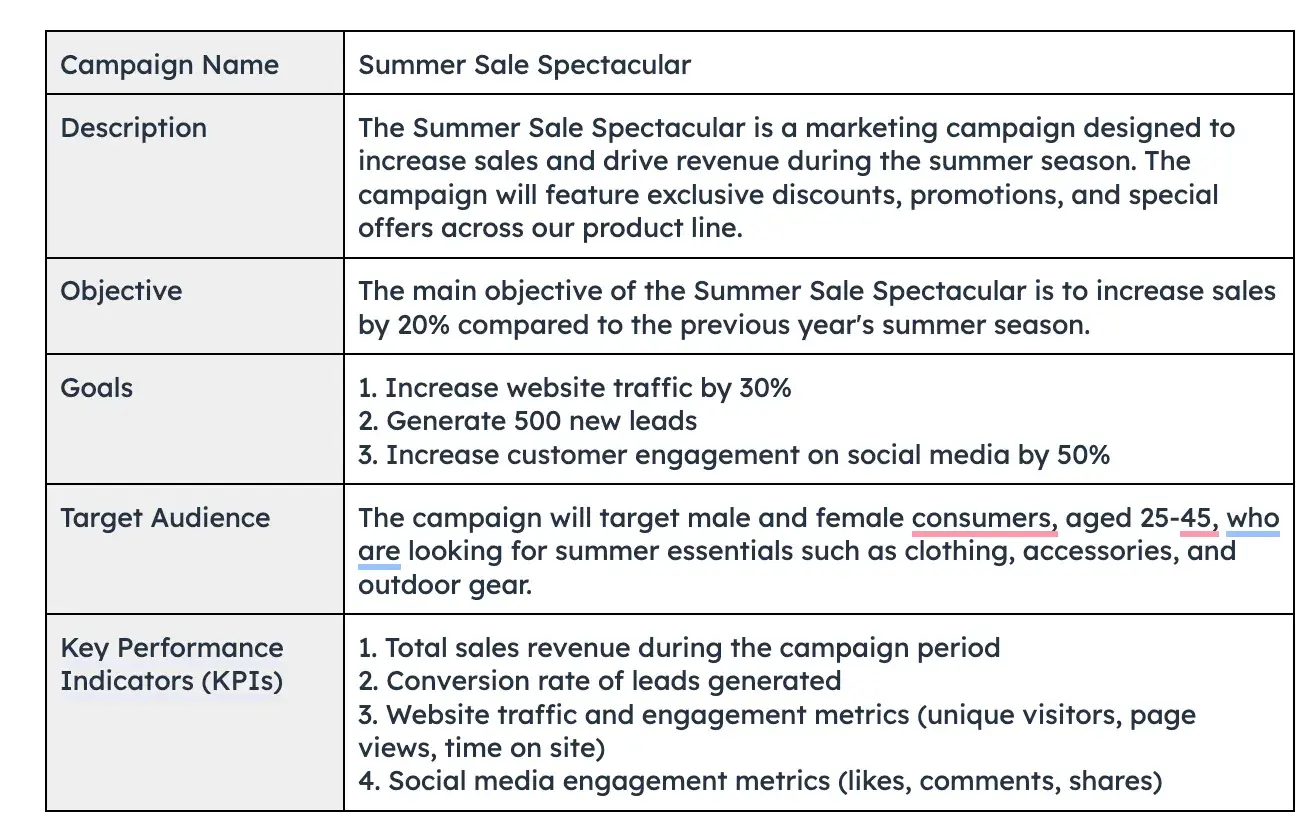
Campaign Strategy
This is your roadmap for executing the campaign and ensures stakeholders have a comprehensive understanding of how the campaign will be implemented.
This section should encompass your value proposition, competitive analysis, messaging and positioning, marketing channels, and required tools.
Example:
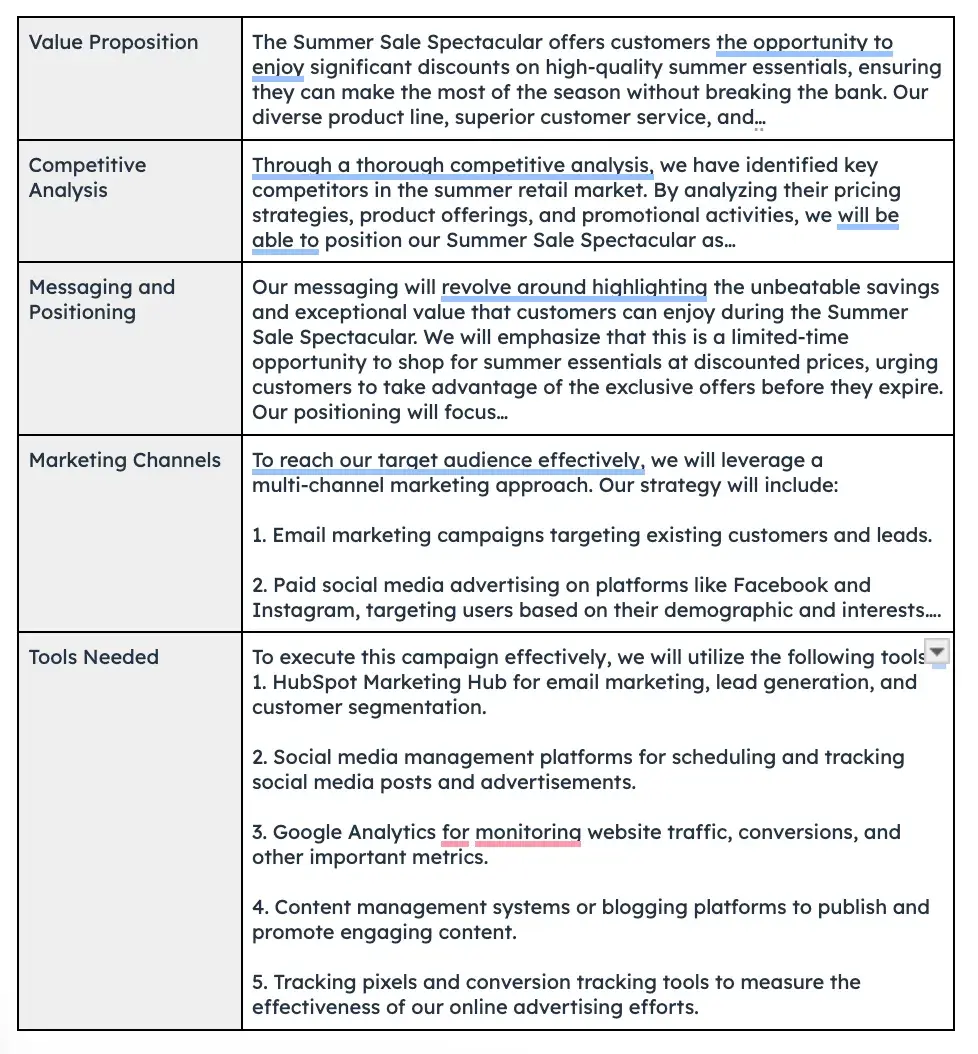
Timeline and Milestones
From pre-launch hype to post-launch evaluation, this section of your marketing campaign plan estimates how long it will take to set up, run, and complete your campaign. It should include your start and end dates as well as major milestones.
Example:
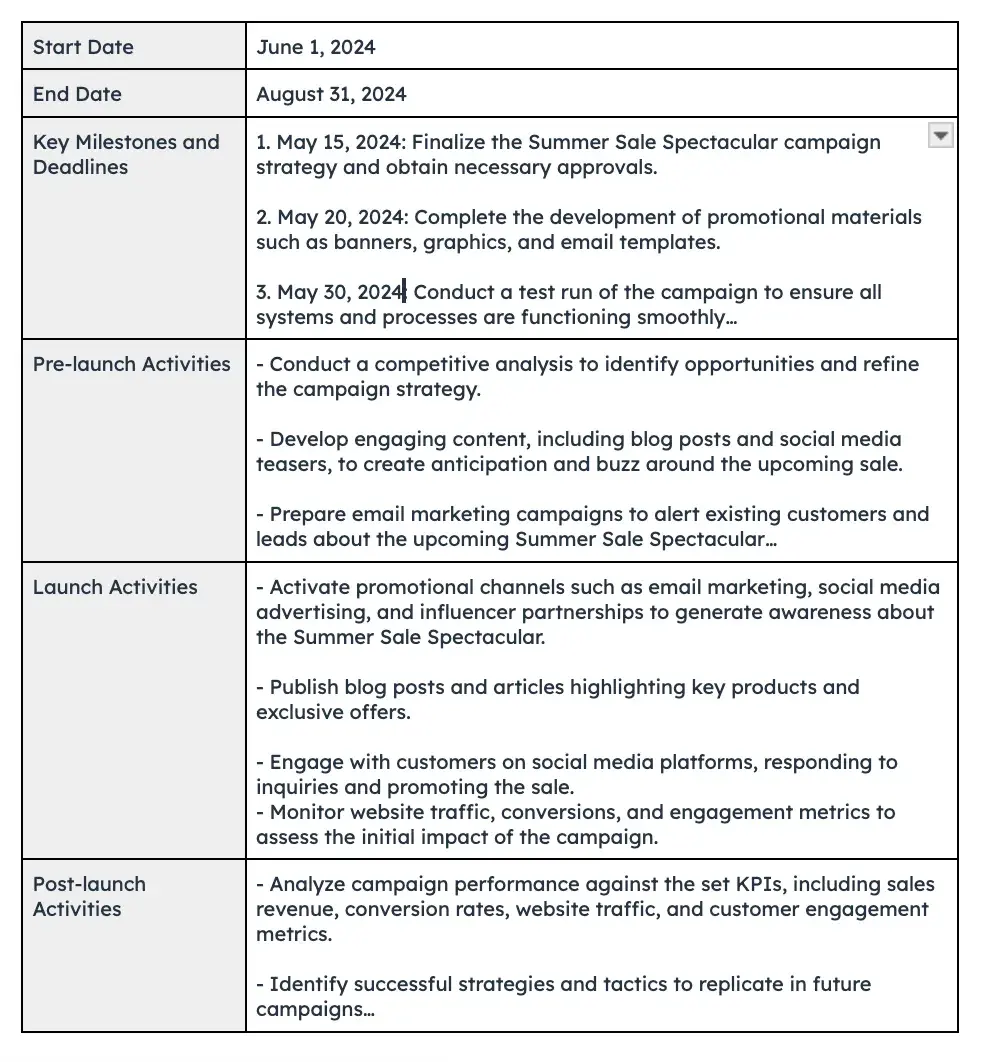
Budget & Resources
Here, you provide an overview of the finances and necessary resources for the campaign.
Identify the budget you’ll need to run your campaign and how it will be distributed. This could include the amount you’ll spend on creating content or ad placements in different areas.
Having these numbers also helps you later when you quantify your campaign's success, like ROI.

Campaign Creative & Assets
This section focuses on the marketing campaign's visual and messaging elements. It encompasses various aspects, including design elements, branding guidelines, tone of voice, and creative direction.
Identify the content you’ll create and distribute during your campaigns — like blog posts, video ads, or email newsletters. Brainstorm content ideas to find relevant topics, set up outlines or creative briefs. Then, add them to your content calendar to establish clear workflows.
This is also where you’ll describe what the marketing campaign will look like and how you’ll use design elements to attract your audience.
Example:

Promotion and Distribution
Here’s where you identify the channels you’ll use to enact your marketing campaign to reach your audience.
Maybe you run a social media campaign on X to raise brand awareness. Or you launch a direct mail campaign to notify your audience of upcoming sales.
Example:

Metrics & Analytics
By leveraging the power of data, you can unlock a deeper understanding of your campaign's impact, identify areas for improvement, and align your marketing efforts for greater success.
In this section, identify the metrics you will use to measure the results of your campaign when it ends (e.g., conversion rates, sales, sign-ups, etc.).
Example:

Team Roles and Responsibilities
Lastly, use this section to identify teams and people who will be involved in enacting your marketing plan from start to finish, such as those responsible for creating your marketing assets, budgets, or analyzing metrics once campaigns are complete.
By clearly defining team roles and responsibilities, everyone can contribute their expertise and work cohesively to achieve the campaign's goals and objectives, ensuring a successful and impactful execution.
Example:
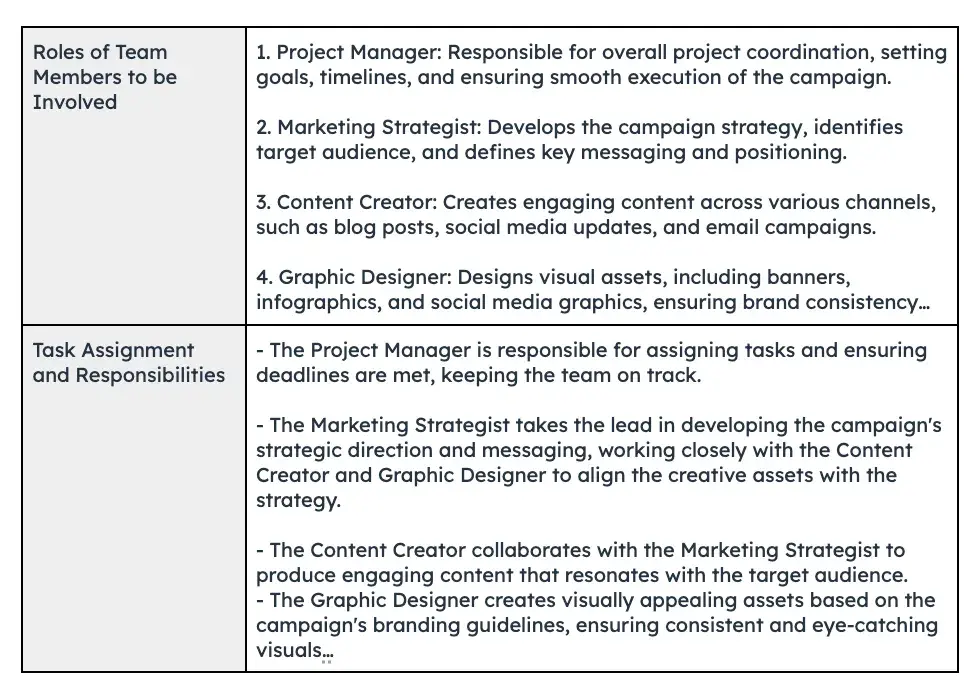
How to get the most out of this template: This template comes filled out with an example of a marketing campaign done right. Read through this thoroughly before filling it out to understand the caliber of detail you should include.
Still getting your feet wet with marketing campaigns? Check out our Ultimate Guide to Marketing Campaigns to dive in.
Digital Marketing Plan Template
A digital marketing plan is similar to a marketing campaign plan. But, as the name suggests, it’s tailored to the campaigns that you run online.
Let’s review the key components of a digital marketing plan template to help you meet your goals.
- Objectives: The goals for your digital marketing and what you hope to accomplish, like driving more traffic to your website. Maybe you want to drive more traffic to your website, or
- Budget: Identify the cost of running your digital marketing campaign and how the money will be distributed. For example, ad placement on different social media sites costs money, as does creating your assets.
- Target audience: Which audience segments are you hoping to reach with this campaign? Identifying the audiences you want to reach with your digital marketing is essential, as different channels house different audience segments.
- Channels: Identifies the channels that are central to your digital marketing campaign.
- Timeline: Explain the length of time your digital campaigns will run, from how long it should take to create your assets to the campaign's final day.
Miro has a free digital marketing plan template to help you outline and document these elements.
Product Marketing Plan Template
Product marketing is a totally different beast from general marketing. So, having a dedicated product marketing plan is essential.
Allie Konchar, Partner & Head of Client Success at Omniscient and former HubSpotter described it best, “Unless you have devoted superfans [like Apple], most people aren’t waiting with their wallets out, ready to buy your next new product. You need product marketing campaigns to hype up your audience.”
To help, we’ve created the Ultimate Product Marketing Go-To-Market Kit, a collection of templates to help your team align on and execute your next product launch.
How to get the most out of these templates: Product marketing is a cross-functional department. Because of this, each template in the kit has its own unique purpose, but “they are best utilized in tandem,” as Stefan Groschupf, founder and CEO of several tech companies including Datameer, explains.
He described how each template should be used:
- Product Launch Planning Template: Create tasks that need to be completed for the product launch, provide progress updates, and plan social media and PR messaging
- Product Update Email Templates: Internally communicate product updates and changes to your team
- Product Roadmap Template: Create a schedule of all the tasks that will be addressed and who will be handling them
- Product Lifecycle Mapping Template: Keep track of your product’s lifecycle stages
- Product Classification Template: Classify your product and align all teams on product vision, marketing plan, and sales strategy
- SWOT Analysis Template: Determine your product’s strengths, weaknesses, opportunities and weaknesses, as well as conduct market research on the competition
- Sales Plan Template: Outline and communicate sales strategy to stakeholders.
Collaborate with your template across each department to complete these templates. This helps ensure the alignment and buy-in needed to execute a successful product marketing strategy.
Social Media Marketing Plan Templates
As your marketing department grows, so will your presence on social media. And, as your social media presence grows, so will your need to measure and plan what types of content you want to publish across each network.
If you're looking for a way to deepen your social media marketing strategy — even further than the marketing plan template above — the following collection of social media marketing plan templates is perfect for you:
Download 10 free Social Media Marketing Planning Templates here.
Let‘s review each template and what you’ll find in each one.
1. Social Media Reporting Templates
If you plan to implement social media in your marketing plan, these reporting templates can help you track your progress. It includes things like total traffic, top posts, channel performance, follower growth, and top landing pages.
What I like: This social media marketing template is actually a collection of templates. It’s a slide deck of editable charts and graphs you can use to report on your social media performance to your team.
2. Social Media Marketing Proposal
With this template, you can create an entire social media marketing proposal. This will outline the social media goals, the scope of the work, and the tactics you plan to implement.
What I like: This proposal can double as a deep dive into the marketing channel section of your marketing plan. It's relatively straightforward and contains all the essential sections of a proposal.
3. Social Media Editorial Calendar
Use this template to organize your social media editorial calendar at a high level. While each platform rightfully calls for its own calendar, having a cumulative document lets your team know what’s going live on any given day “at a glance.”
What I like: This calendar makes tracking activity across every social media platform easy since each platform is assigned a specific color.
4. Facebook Live Schedule
You’ll find a tab dedicated to Facebook Live in our Facebook content calendar template. This template will help you organize what live events you want to do and when.
What I like: Once you've decided on dates, you can color-code your Facebook calendar and coordinate with your editorial calendar. That way, everyone can see what lives are running in relation to other campaigns.
5. Instagram Content Calendar and Inspiration Log
Using Instagram regularly? Do you want to increase your following? With this template organize and plan future Instagram posts.
What I like: This is more than just a content calendar. You can use this doc to collaborate with your team on messaging, landing pages linked in your bio, and campaign rollouts.
6. Hashtag Holidays
If you're going to use social media in your marketing plan, you can use hashtag holidays to show personality, stay relevant, and reach new audiences.
What I like: These holidays are a fun way to fill out your social media publishing schedule. With this template, you'll get a list of the most common hashtag holidays for the year.
7. Social Media Audit
Conducting a social media audit? This template can help you gather the right analytics. Tracking the results of your marketing efforts is key to determining ROI.
What I like: Use this template to track your social media campaigns to determine what worked and what didn't. From there, you can allocate funds for the strategies that deliver desired results.
8. Social Media Image Sizes
With this template, your team can have the latest social media image sizes handy. This template includes image sizes for all major social media platforms, including Facebook, Instagram, and X.
What I like: Having a resource like this handy for your team helps ensure any content you create will be optimized for the platform it’s going on. It will be correctly sized so no content will get cut off or poorly displayed.
9. Social Media Software RFP Questions
This template lists questions to help you decide which social media management platform your business should use.
What I like: Once you decide on the social media tactics you'll implement in your marketing plan, this template can help you determine which tool will be best for making them happen.
10. Paid Social Media Template
With this template, you can organize your annual and monthly budget for your paid social media calendar.
What I like: All you need to do is plug in your numbers, and the formulas will do the work for you. I recommend using this in conjunction with your marketing plan budget to ensure you are not overspending and funds are allocated appropriately.
Set your marketing planning process up for success.
A marketing plan is crucial to your greater marketing results, but don’t let this importance intimidate you.
Whether you’re a seasoned professional or just getting started, with all of the marketing plan templates, examples, and advice shared, you have everything you need to set your marketing planning process up for success.
Editor's note: This post was originally published in December 2016 and has been updated for comprehensiveness.





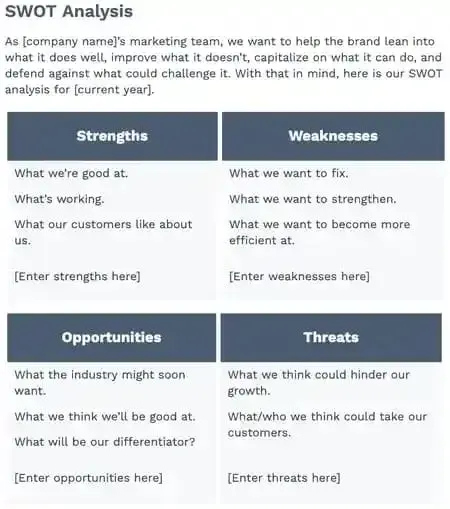


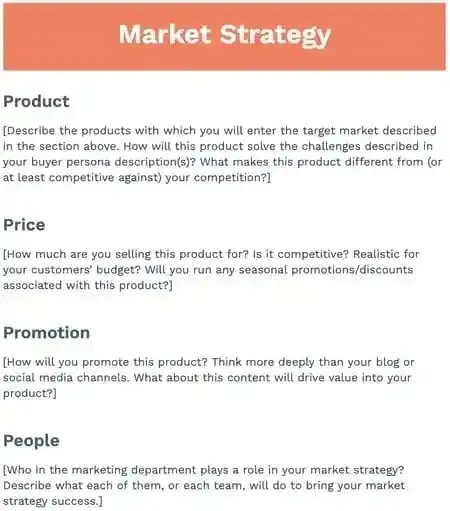


.webp?)



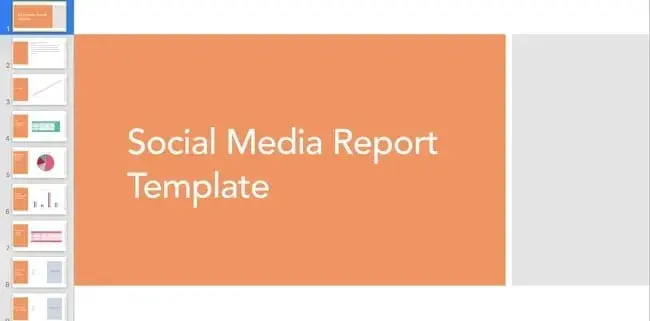

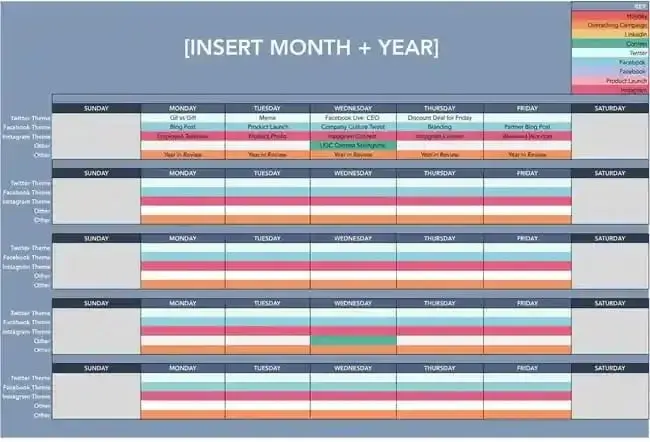
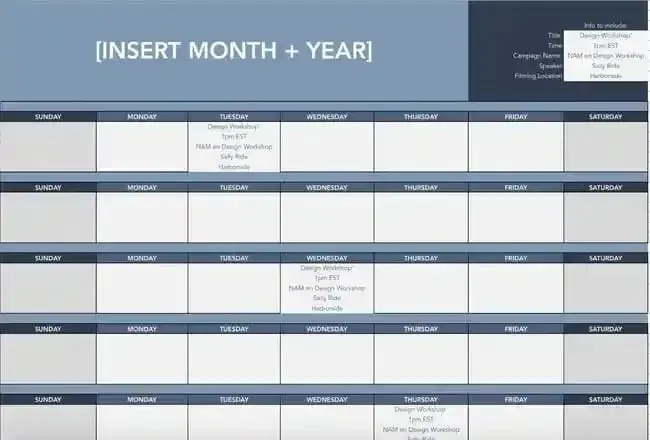
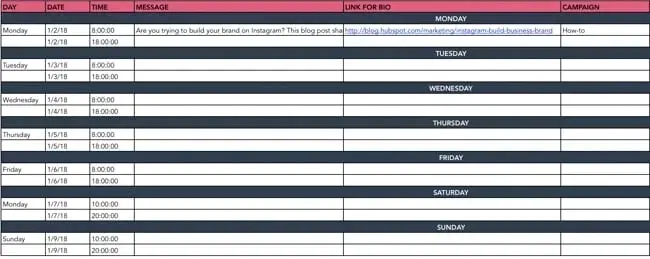

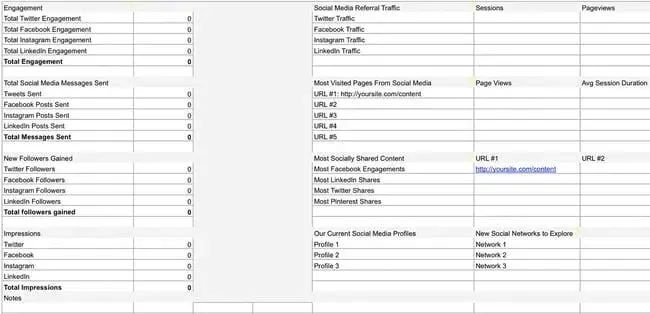
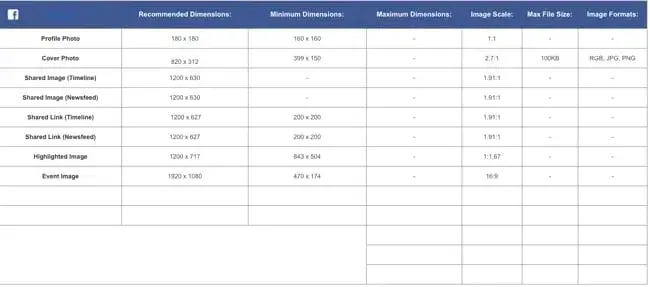
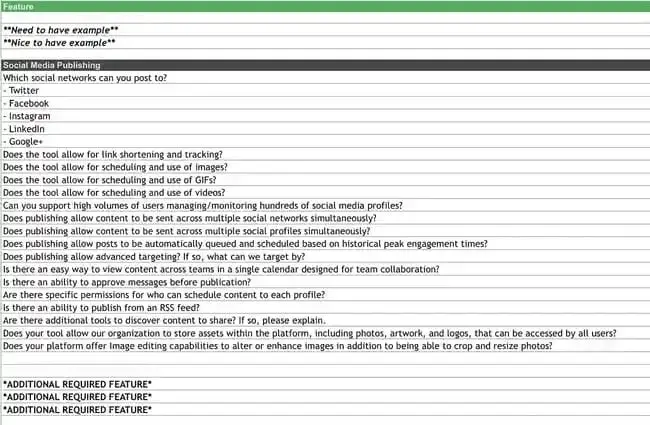
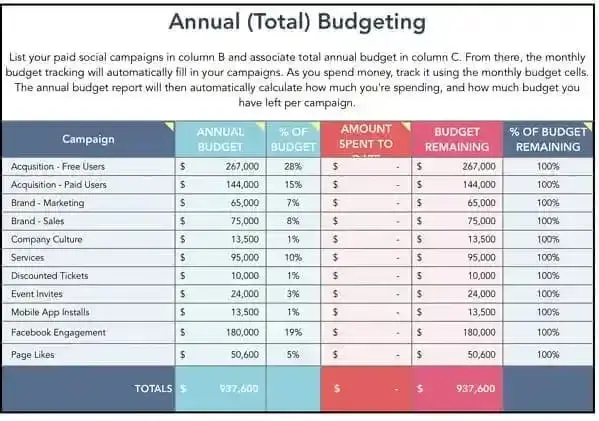
![What is a marketing plan & how to write one [+ examples]](https://53.fs1.hubspotusercontent-na1.net/hubfs/53/marketing-strategy-examples-1-20240801-4880441-1.webp)


![How to Build a Market Development Strategy [Free Planning Templates]](https://53.fs1.hubspotusercontent-na1.net/hubfs/53/market%20development%20strategy.jpg)
![How to Build a Robust Direct Marketing Strategy [+ Examples]](https://53.fs1.hubspotusercontent-na1.net/hubfs/53/direct%20marketing.jpg)